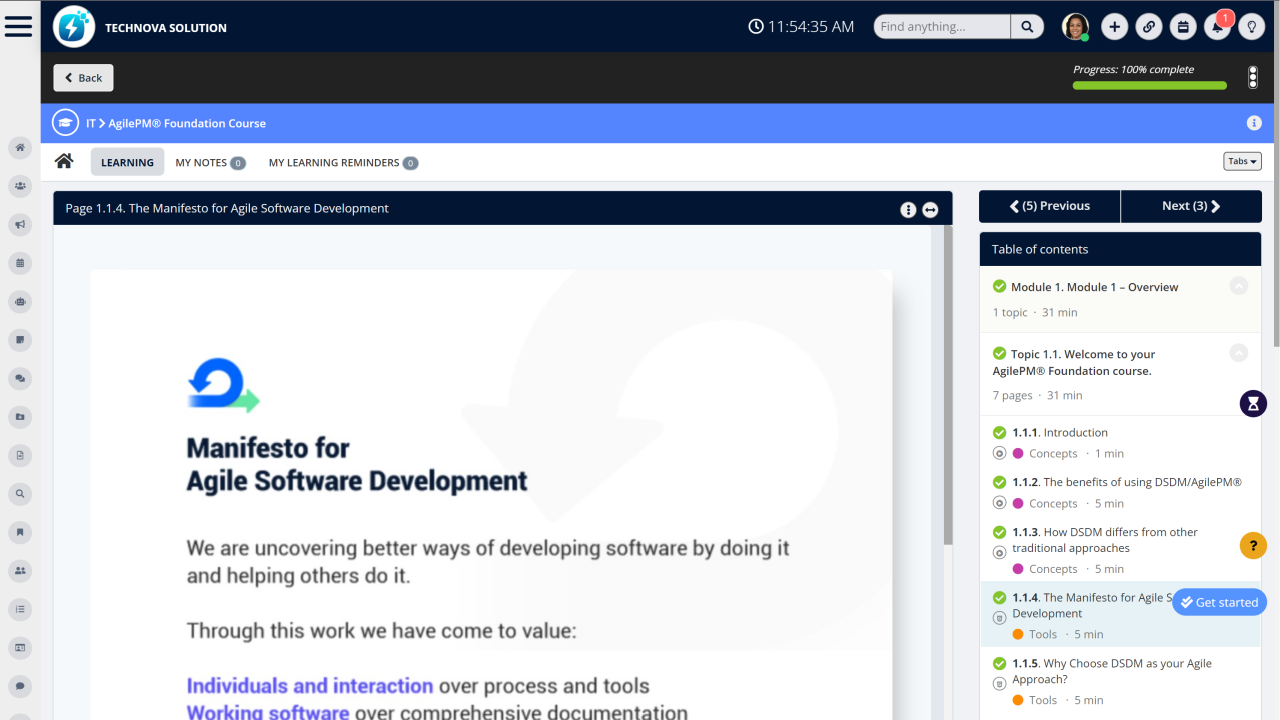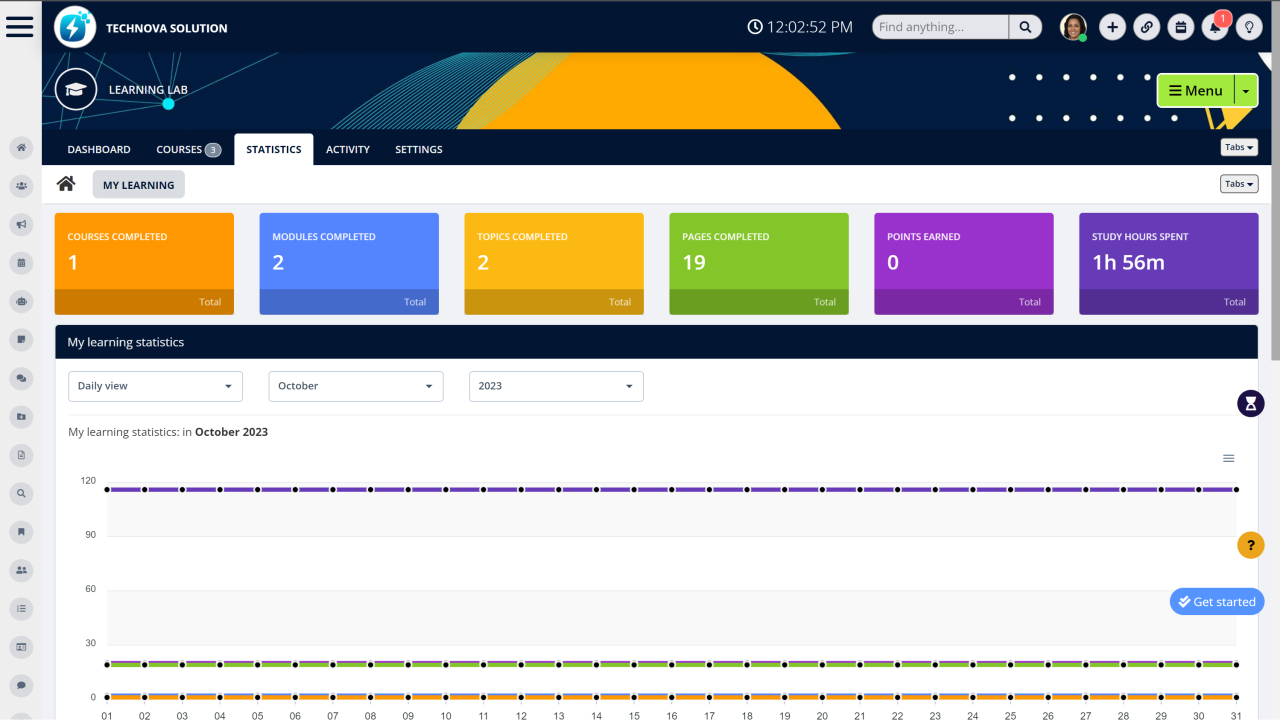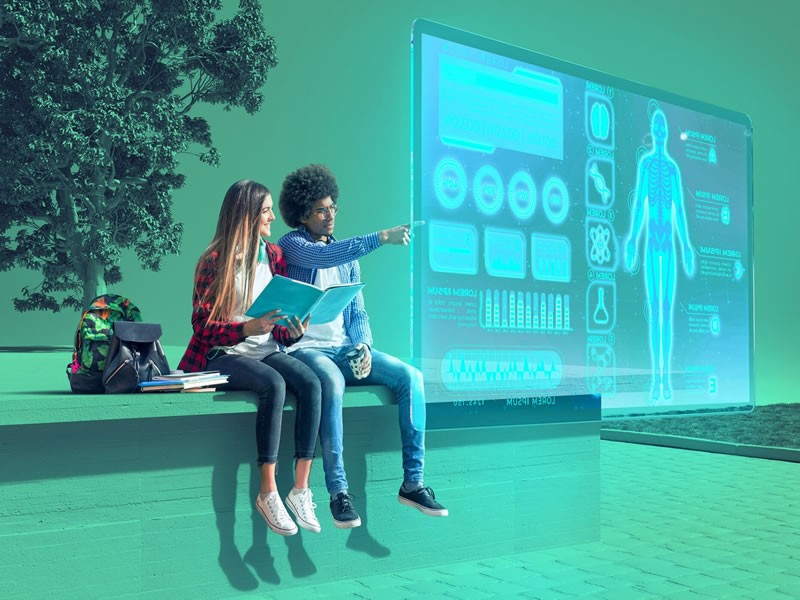Insight Blog
Agility’s perspectives on transforming the employee's experience throughout remote transformation using connected enterprise tools.
13 minutes reading time
(2600 words)
The Future of Learning: Potential and Power of Learning Management Systems
In this article, we examine the advantages of learning management systems and how they transform the educational process for both students and teachers.
The educational landscape is always changing and catching up with new technological developments.
Due to the emergence of digital solutions, education has also moved online, making contemporary platforms, namely learning management systems (LMS), crucial to the processes of learning and growth.
In this article, we examine the advantages of learning management systems and how they transform the educational process for both students and teachers.
What Exactly Is an LMS?
A software program called an LMS (Learning Management System) enables you to plan, organize, and build an online training strategy as well as give your students access to online learning resources. They might be licensed, open-source, or custom solutions developed with the help of LMS development services.
LMSs are perfect for blended learning, which mixes online and in-person learning, as well as e-learning and distant learning. These programs are designed for trainers and remote training specialists who are interested in gradually digitizing their content.
Some of the key features of LMSs include:
- Course creation and delivery tools
- Learner enrollment and management tools
- Assessment and performance tracking tools
- Reporting and analytics tools
LMSs can be used to support a wide range of training needs, including:
- Employee onboarding and training
- Compliance training
- Sales training
- Customer service training
- Product training
- Soft skills training
- Language training
LMSs can also be used to support continuous learning and development initiatives.
By providing employees with access to a variety of training resources, LMSs can help them to develop the skills and knowledge they need to succeed in their current roles and prepare for future opportunities.
Here are some of the benefits of using an LMS
Here are some of the benefits of using an LMS:
- Improved training efficiency and effectiveness: LMSs can help organizations to improve the efficiency and effectiveness of their training programs by automating many of the tasks involved in training delivery and management.
- Increased learner engagement: LMSs can help to increase learner engagement by providing learners with access to a variety of interactive and engaging learning activities.
- Improved learner performance: LMSs can help to improve learner performance by providing learners with opportunities to practice what they have learned and receive feedback on their progress.
- Reduced training costs: Learning Management Systems (LMSs) are invaluable tools for organizations aiming to enhance their training and development programs. By providing a centralized platform, LMSs simplify the creation, delivery, and management of training initiatives, significantly reducing costs and administrative overhead.For example, professionals preparing for certifications like Microsoft AZ-900 Practice Test Dumps can access structured courses, interactive content, and progress tracking through an LMS, ensuring a more focused and effective study experience.Benefits of LMS for Training Programs
- Cost Reduction: LMSs eliminate the need for physical materials and on-site trainers by digitizing training programs, resulting in substantial savings.
- Centralized Access: Organizations can deliver and manage training for a wide range of audiences from a single platform, ensuring consistency.
- Tracking and Reporting: Advanced analytics allow tracking of learner progress, course completion rates, and performance metrics, enabling organizations to fine-tune their training strategies.
- Improved Engagement: Interactive elements like quizzes, gamification, and multimedia content enhance learner involvement and retention.
Can LMS Be Beneficial for Businesses?
Business organizations may find great value in learning management systems. LMS solutions allow companies to create engaging and individualized learning experiences by acting as a central focus for staff training and development.
LMS solutions expedite the learning process, measure progress, and guarantee compliance with training needs for everyone, from onboarding new hires to upskilling current staff.
LMS platforms give companies the tools they need to improve employee knowledge, productivity, and overall organizational performance with features like interactive material, exams, and analytics.
Follow us and access great exclusive content everyday: Follow us on Google News
Advantages of Learning Management Systems
Centralized Repository for Learning
LMS platforms act as centralized repositories, collecting a substantial volume of instructional content. As a result, there is no longer a need for physical storage, and various learning resources, such as papers, presentations, videos, and tests, may be easily organized and managed. The materials that students require are easily accessible, resulting in a smooth learning process.
You may also like: Best Apps for Employees: UPDATED 2022 – A Complete Guide
Insights Based On Data
To monitor student development and make wise decisions, instructors can use the real-time data and analytics provided by a contemporary e-learning platform. Insights give information on the success of teaching techniques and help spot areas where students might be having difficulty.
Streamlined Management
The capacity of an LMS to simplify administrative processes related to education and training is another important benefit. The design, management, and distribution of courses are all made more effective with an LMS.
Administrators can efficiently manage and deploy material to various learner groups, monitor progress, and produce detailed data on engagement and performance. Additionally, automated grading and assessment tools free up instructors' important time so they may use it to give students-specific comments and direction.
Because of the huge reduction in administrative work, educational institutions and other organizations may better allocate resources and simplify processes.
Free ebook: How To Get Your Intranet Off The Ground
Scalability and Affordability
The scalability provided by learning management systems enables businesses and educational institutions to accommodate expanding student populations without making substantial infrastructure expenditures.
LMS platforms may quickly grow to suit the demands of small businesses, large corporations, or educational institutions thanks to cloud-based solutions.
In fact, the number of LMS users is currently estimated to be 73.8 million, making this a massive market. Additionally, LMS systems lower the expenses associated with conventional learning techniques by doing away with the requirement for real classrooms and printed materials, making education more affordable and accessible.
Personalized and Intuitive
By using an LMS to assess present skill levels and determine what training is required, time may be saved. According to your students' existing knowledge or skill level, this system can detect where they are in the learning process and provide them with personalized learning materials.
Emerging Trends in LMS: Personalization and Adaptive Learning
Learning management systems (LMS) have evolved into powerful tools that can adapt to the needs of individual learners. In this section we'll look at two exciting new trends: personalization and adaptive learning.
Personalized learning is a broad term that refers to any type of instructional design, curriculum development or pedagogical approach that is tailored specifically for an individual student's needs and goals. It's more than just tailoring content it means considering each student as an individual with their own strengths, weaknesses, interests, motivations and knowledge base when designing instruction for them.
This can include everything from selecting appropriate resources based on what you know about your students' interests or providing guided practice activities based on their skill level or previous experience in the subject matter area being taught (a subject-specific version of "learnings by doing").
Adaptive learning platforms allow teachers and instructors to create customized lessons based on each student's performance throughout the course (or during particular modules).
Adaptive software provides feedback on how well students are understanding concepts as they progress through each lesson; if there are areas where they struggle with comprehension then additional remedial support may be provided until mastery has been achieved before moving forward again towards more complex concepts later in the course.
Integration of Multimedia and Interactive Elements in Modern LMS
The Importance of Integrating Multimedia and Interactive Elements in LMS
Learning management systems are software solutions that help educational institutions create, deliver and track courses online. They have been around for many years now and have evolved significantly with technology changes over time. One of the main ways they have evolved is by adding multimedia elements to their platforms so that learners can learn more effectively using them.
Benefits of Integrating Multimedia and Interactive Elements in LMS
Multimedia content allows learners to engage with information in more meaningful ways than just reading text on a page or watching videos on YouTube it encourages them to think critically about what they're learning and apply it in real life situations (which is especially important if you're using an e-learning platform).
Interactive features such as quizzes also encourage active participation from students by requiring them to answer questions before moving onto another topic within a lesson plan; this helps ensure comprehension while making sure nothing goes unnoticed during any given lesson period.
Challenges in Integrating These Elements into Existing Platforms
There are some restrictions depending on what type of license agreement has been signed between vendor companies involved (i..e., software developers), but there are always workarounds available if needed.
The Role of Artificial Intelligence in Enhancing LMS Capabilities
Learning management systems have a lot to offer, but they have their limitations. Artificial intelligence (AI) is one of the ways that technology can be used to enhance LMS capabilities. AI can help with:
Personalization and Adaptive Learning
The ability of a learning management system to personalize content based on user preferences and interests. Adaptive learning involves tailoring instruction based on performance data from each student as well as identifying gaps in knowledge so that learners receive only relevant information at the right time during their journey through the course material.
Integration of Multimedia and Interactive Elements
The use of video clips, images, simulations, animations and other types of media that give users hands-on experience with concepts learned from reading text-based materials alone; these elements are often referred to as "rich" because they provide additional context for understanding key concepts presented online such as how something works (e.,g., using an animated diagram vs just reading about how something works).
They may also include quizzes or games which require students' active participation while they learn new skills through practice rather than just passively absorbing information without putting anything into action until later when it becomes necessary during actual work conditions outside school hours/terms etcetera...
Gamification and Microlearning: Transforming Education through LMS
Gamification is the process of applying game mechanics to non-game contexts. Games are fun, and if we can make learning more like games, then it will be more engaging for students and easier for them to retain information. This can be done through badges, points, leaderboards and levels of achievement.
The potential for gamification in LMSs is limitless: you can use it as an incentive system for completing courses or assignments; you can track student progress throughout the course with leaderboards; or even provide microlearning lessons that help students master skills at their own pace (e.g., after every five lessons complete).
Addressing Challenges in LMS Implementation and Adoption
Learning management systems (LMS) are complex and can be expensive to implement. This is why it's important to understand the challenges in LMS implementation and adoption, as well as how they can be overcome.
Complexity
The first challenge is that LMS implementations tend to be very complex. This means there are many moving parts involved from start-to-finish, which makes it difficult for organizations to get everything right on the first try or even second or third tries!
For example, you may need expertise in HR, finance and operations so that you can make sure your LMS will meet all of their unique needs and those aren't easy skillsets for everyone!
Cost
Another challenge is cost many organizations find themselves spending more money than originally anticipated when implementing an LMS system because they didn't account for all costs associated with the project (e.g., hardware upgrades).
But even if an organization does budget appropriately upfront, there may still be costs down the road due simply because changing processes takes time away from other projects/activities within an organization like updating training materials or creating new assessments based off what was learned through implementing an LMS system initially.
LMS Security and Privacy: Safeguarding Learners' Data
Security and privacy are two of the most important aspects of any learning management system.
This is because it's critical to safeguard the data of learners, who are often vulnerable to cyberattacks, identity theft, fraud and other cybercrimes.
The first step in creating a robust security system for your LMS is to ensure that all data stored on your servers is encrypted using industry-standard cryptographic methods.
You also need to implement software firewalls that will block unauthorized access attempts from hackers attempting to break into your site or steal sensitive information such as passwords or credit card numbers from students' accounts (and thus gain access).
One way you can further protect yourself against cyberattacks is by implementing two-factor authentication (2FA), which requires users who sign into their accounts via mobile apps like Google Authenticator app instead of just entering username/password credentials this makes it harder for hackers who have stolen those credentials from one account owner's computer due out another user's account without having physical possession over both devices at once!
LMS Analytics: Harnessing Data for Continuous Improvement
The potential of LMS analytics is to improve the effectiveness of your training program and learning management system. By measuring retention rates, time spent on each module, engagement levels and other metrics, you can identify areas where your employees need more support or reinforcement.
The data you collect can provide actionable insights into how they're interacting with content and help you make decisions about future development plans.
Analytics are also useful for measuring the effectiveness of training programs themselves: Do they meet their objectives? Are they producing results that align with your goals? This information can be used in tandem with other metrics like employee turnover rates or customer satisfaction surveys (which we'll discuss later).
Finally and perhaps most importantly analytics give us insight into how well our LMS performs over time as new features are added or existing ones modified; this helps us avoid problems before they occur so we can focus on improving processes rather than fixing them after problems arise.
Mobile Learning and Offline Access: Extending the Reach of LMS
Mobile learning is the use of mobile devices to deliver and receive training. Mobile learning allows you to access your LMS from anywhere, at any time and on any device.
Offline access is the ability to access content and resources even when you are not connected to the internet. The ability to access content and resources offline is important for a variety of reasons including:
- It allows students who do not have reliable internet connections (such as those who live in rural areas) access course materials whenever they need them;
- It makes it possible for trainees who travel frequently between different countries or cities with different computer systems;
- It provides employees with an additional way of accessing their company's intranet without having them install any software on their personal computers or laptops
Wrapping up
To improve the learning experience, businesses, and educational institutions cannot function without learning management systems.
By utilizing learning management systems, administrators may expedite learning administration and efficiently measure progress while learners can participate in interactive and individualized learning experiences.
Learning Management Systems can completely change education and training as long as technology keeps advancing.
Categories
Blog
(2584)
Business Management
(318)
Employee Engagement
(204)
Digital Transformation
(171)
Intranets
(119)
Growth
(117)
Remote Work
(61)
Sales
(48)
Collaboration
(37)
Culture
(29)
Project management
(29)
Customer Experience
(26)
Knowledge Management
(21)
Leadership
(20)
Comparisons
(5)
Ready to learn more? 👍
One platform to optimize, manage and track all of your teams. Your new digital workplace is a click away. 🚀
Free for 14 days, no credit card required.
















